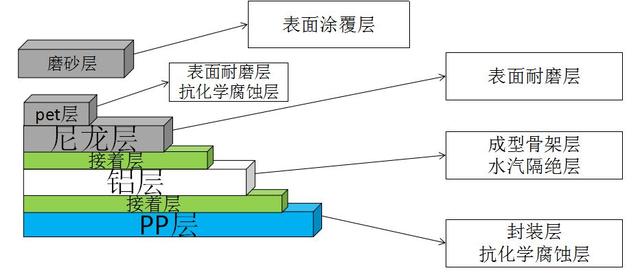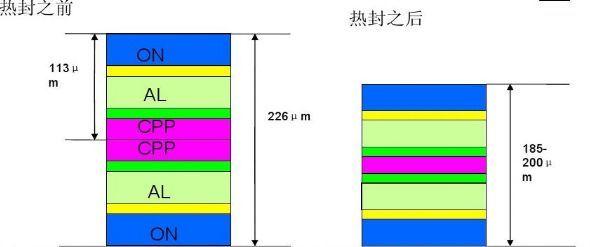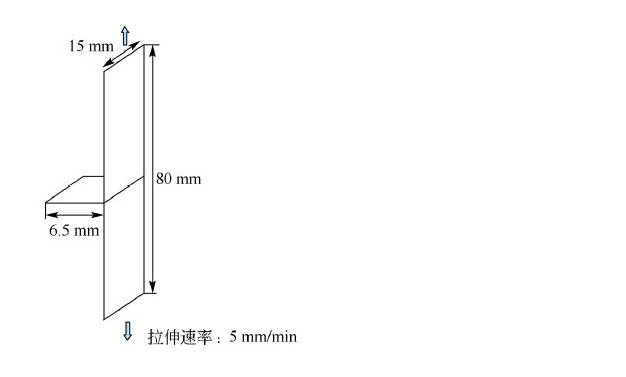Pouch cell pack lithium battery: heat sealing process Analysis of the influencing factors
The packaging material used for soft pack lithium batteries is aluminum-plastic composite film, referred to as aluminum-plastic film. Before encapsulating a bare battery cell, the aluminium-plastic film is punched and cut to the required size before encapsulating the battery cell.

Aluminium composite film structure
The innermost material of the punched pits is cast polypropylene film (CPP), which has a certain melting point and melts and bonds together under a certain temperature and pressure on both sides of the CPP layer.
CPP layer material has good heat sealing bonding with metal Ni, Al and lug adhesive, and itself has good electrolyte resistance and HF resistance, while CPP layer also has good insulation and physical protection performance, which can effectively prevent the short circuit between electrode and lithium-ion battery soft package material and thus cause corrosion of the aluminium-plastic film.
The Al layer in the middle is to prevent the infiltration of moisture in the air, which will react with the electrolyte to generate HF and form a side reaction to produce a large amount of gas, causing the Li-ion battery to bulge, which is one of the important hidden dangers of Li-ion batteries.
The outermost nylon layer is mainly to prevent the penetration of oxygen in the air and to maintain the internal environment of the cell. The outermost nylon layer is also used because of its good punching performance. PET was used as the outer layer in early Al films, but it was abandoned due to its high tension, resulting in bending and poor mouldability.
The two main methods of manufacturing aluminium-plastic films are thermal and dry.
In the thermal process, the aluminium layer is bonded to the CPP layer with MPP, which is hot pressed at a certain temperature. At high temperatures the van der Waals forces in the MPP are destroyed, ageing and the resistance to short-circuiting decreases dramatically. At the same time, its intermolecular structure is destroyed, resulting in reduced toughness and easy rupture during the forming process.
The dry process is a direct composite with binder in the middle of the PP and aluminium layers, using an insulating binder, without high temperature treatment so the short circuit resistance is better than the thermal process. The binder itself is more ductile than the PP layer and does not require high temperature treatment to affect the moulding.

Exploring the impact of heat sealing
The first thing to understand is that the purpose of heat sealing is to completely isolate the core from the outside environment, i.e. everything that could affect the outside moisture, air infiltration and electrolyte leakage should not occur. The encapsulation of soft pack cells is divided into a top and side sealing process and a final sealing process.
The top sealing process is the direct encapsulation of the aluminium plastic film, lug adhesive and copper-nickel lugs, which has a high potential for breakage. The side seal is the encapsulation between the CPP layers of the aluminium-plastic film, which does not pose too many problems, but mainly prevents wrinkles and bubbles from appearing. The final seal is a vacuum seal, as the pre-charging of the lithium battery will produce gas, the electrolyte will also tend to stick to the aluminium-plastic film PP layer, resulting in poor packaging.
During the production process, technicians commonly use six aspects of human-machine, material and environmental testing to explore the failure modes. Firstly, we need to eliminate the secondary influencing factors, which are personnel, environment and testing methods. The personnel's level of operation and work experience has an impact on the encapsulation effect, here we set the personnel's level of operation to be certain and unproblematic. The test methods are certain, and the verification of the encapsulation effect is obvious and does not require anomaly analysis.
The workshop environment needs to be cleaned up and confirmed before encapsulation takes place, including foreign objects on the table, impurities and ambient temperature and humidity. The following is an analysis of the main factors that affect the effectiveness of heat sealing, namely materials, equipment and processes.
1. Materials
Incoming material inspection is an important method to prevent abnormal inflow, and an important means to reduce the rate of non-conforming products and production costs. There are two main aspects of incoming materials in the packaging process: one is the aluminium plastic film itself, and the other is the incoming material of the bare battery core. The problem of the aluminium film itself includes the abnormalities of the film itself and the abnormalities introduced by the punch pit. The aluminium film itself should be observed for its normal colour, bubbles, stains and scratches on the surface. Other properties of the aluminium-plastic film itself will be provided by the supplier, such as the peel strength of the aluminium foil and PP layer, processing properties, permeation resistance, etc.
Lithium battery companies will also test the incoming material to confirm it is ready for use. Punching of the aluminium plastic film is for good and beautiful packaging. The main defects introduced by punching are CPP breakage, pit abnormalities, etc. These abnormalities can lead to corrosion of the aluminium plastic film and high stress on the edges of the lithium battery injection.
The key to the quality of the pit punch is the design of the pit punching tool, which consists of a concave die, a convex die, a pressure plate and other auxiliary devices, and requires the design of the length, width and depth of the die according to the shape and size of the battery. The design of the die length, width and depth is based on the cell shape and size. The clearance of the concave and convex dies is based on the depth of the pit and the surface roughness of the concave and convex dies is based on the processing characteristics of the aluminium plastic film. The main problem with the incoming bare cell material is the contamination on the surface of the lugs, which may cause poor packaging.
2. Equipment
The design and structure of the equipment moulds are undoubtedly important for the packaging results. In the top sealing process, due to the presence of positive and negative lugs, there are uneven contact surfaces between the aluminium plastic film and the lug rubber, so it is necessary to ensure that the PP layer of the recruiting plastic film is well bonded and sealed with the PP layer on the outer surface of the lugs, and to ensure that the PP layer of the aluminium plastic film is well bonded and sealed face to face in the non-lug area.
The design of the encapsulation mould and the choice of the head are crucial. When using a hard seal, silicone can be added to the hard seal head to compensate for the deformation of the silicone at the top seal, or a mould can be designed for the hard seal mould to dig a recess to match the lugs for encapsulation. The soft seal does not require as much consideration, but attention must be paid to the encapsulation process to verify the seal and the ageing of the high temperature resistant adhesive.
Too large a thickness is essentially a failure to encapsulate the aluminium film, and in the case of equipment, it may be due to low pressure or abnormal sensors and unstable compressed air pressure. Too small a thickness means that the film is over-sealed, which may result in the PP layer melting too much and exposing the aluminium layer. The equipment can be fitted with appropriate limiting devices to achieve the best possible encapsulation. In addition, abnormalities in the temperature sensor can lead to over- or under-sealing due to failure to reach the set process temperature, resulting in poor encapsulation.
3. Process
The key factors in the encapsulation process are temperature, pressure and time. The optimum state of encapsulation is when the PP film has reached its melting point, is bonded together, has a good appearance with no bubbles or wrinkles, has high strength, has a good seal and passes the insulation test.
The strength of the package is tested with a tensile testing machine, the schematic of which is shown in Figure 3. In addition to the way in which the specimen is stretched can choose to stretch horizontally and longitudinally, tensile testing machines have horizontal tensile testing machines and vertical tensile testing machines, generally speaking vertical testing machines are generally electronic universal testing machines, sensors in the mobile end, so the vertical can do peel, stretch, compression, sharpness of these tests. As far as stability is concerned the horizontal testing machine dedicated to peel force is a little better than the vertical electronic universal testing machine, both have to choose the right range of sensors. Appearance is checked by visual inspection, and sealing is tested by vacuuming. Insulation testing is done by applying momentary high voltage to the pole lugs and the aluminium-plastic film to test for good encapsulation, detecting defective products in advance and preventing them from flowing out.

Once an aluminium film has been selected, a three-factor DOE of temperature, pressure and time is carried out to confirm the optimum encapsulation process. The PP melting temperature of aluminium-plastic film is usually between 180°C and 190°C. Several temperature points within a certain range can be selected for heat sealing experiments at the same pressure and time to determine the optimum sealing temperature through the strength and effectiveness of the seal. Correspondingly, the effect of heat sealing pressure and time on strength and encapsulation effectiveness can also be determined.
After correlation analysis, it is possible to identify which factor is the main influence. Generally speaking, the strength of the seal increases with the temperature of the seal and may lead to over-sealing when the temperature reaches a certain level, with the PP melt spilling out of the heat seal area and forming cracks when it cools down, thus reducing the strength of the seal. The optimum time for heat sealing is temperature dependent. When the temperature is low the heat sealing time has little effect on the strength because the PP layer does not reach its melting point at low temperatures and the heat sealing layers are not fused together.
When the temperature is high enough, heat seal time is positively correlated with heat seal strength. Encapsulation pressure affects the thickness of the seal, but is a less important factor than temperature and time. During the daily use of the encapsulation equipment, attention should also be paid to the flatness and parallelism of the head, confirming that the head temperature and temperature sensor are normal, etc., and solving the corresponding problems when abnormal temperatures are found.
The encapsulation of the core is a key process that affects the final performance of the core. The main factors affecting the encapsulation of aluminium-plastic film are the selection of equipment and moulds, and the determination of the encapsulation process. Secondary influences include the quality of the incoming material, the ability of the operator and the workshop environment. Only by coordinating all aspects can we do a good job of encapsulating the cores, preventing corrosion of the electrolyte while isolating the interior of the core from the external environment and preventing the infiltration of water vapour to ensure the cycle life and safety of the lithium battery.






























 401,Building A1,No.168,Changshan IndustrialZone Liulian Community,Pingdi Street,Shenzhen Guangdong Province,China
401,Building A1,No.168,Changshan IndustrialZone Liulian Community,Pingdi Street,Shenzhen Guangdong Province,China